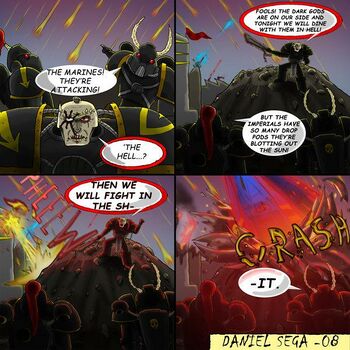Drop Pod

Just about every modern sci-fi setting has a military that uses Drop Pods to deploy; if you take a sufficiently broad interpretation, you could say that the Martian cylinders from H. G. Wells' The War of the Worlds were the very first, but it was Robert Heinlein's Starship Troopers that really crystallized the concept as we know it: a means of getting super-elite soldiers right where they are needed, when they are needed, and in style.
Starship Troopers
Each member of the Mobile Infantry gets his own pod, containing his suit of armor. The armor is actually perfectly capable of surviving re-entry, and can even fly ("a little," as Heinlein writes); the pod is actually meant to disintegrate in the atmosphere, giving the Mobile Infantryman a cloud of chaff to confuse ground defenses.
Warhammer 40,000
The Space Marine's iconic deployment method. A pod holds ten (or twelve, if you're a Codex Astartes-compliant chapter) Marines, or one Dreadnought, or one Thunderfire cannon. It takes a lot of the guesswork out of Deep Striking because it avoids obstacles automatically -- that's why Boreale loves them so much.
Deathstorm Drop Pod
A drop pod can hold weapons instead of soldiers. If a drop zone is just too hot to land in, the Space Marines will use Deathstorm Drop Pods (equipped with assault cannons or Whirlwind missile launchers) to clear the way. They're only BS 2, but they compensate through volume of fire.
Lucius Pattern Dreadnought Drop Pod
A drop pod with all the restraints and harnesses taken out, and only three fins instead of five. This means that only a Dreadnought can survive landing in it, but it also means that they get to assault as soon as they land.
Dreadclaw Assault Pod
The older, more advanced pattern of Drop Pod used during the Great Crusade, and possibly even earlier. They have many major advantages over their current Imperial counterparts, but chief among them was that they could take off and fly on their own, even after landing. Some even suspected their Machine Spirit was dangerously close to true Abominable Intelligence. The big problem was...well how to put it? These pod's Spirits were rather not nice. Marines who went in sometimes ran into 'accidents'. Rather nasty ones. Safety harnesses suddenly unbuckling mid-descent. Crew pods jettisoned in space. Failure of backthrusters to turn on. Crews mulched by whirring machinery...while most people kind of accepted these rare and small costs, some worried and began to look deeper. If it wasn't obvious then, something was indeed fucking obvious when Horus declared his rebellion. Suddenly, the rate and amount of accidents was drastically increasing on loyalist pods, while rebel pods would do the kitty cat equivalent of purring contentedly on the traitors' laps. These kind of machinery-accidents spread on Imperial vessels during the Horus Heresy, to the point where many Imperial Navy admirals just jettisoned their Dreadclaws into the void of space rather than risk having them sabotage the ships. After the Heresy, while no one could really figure out what was wrong, it was deduced that there was a deep, Chaotic flaw in their design, so the Imperial fleets who hadn't already done so had their remaining stock destroyed.
The Chaos Space Marines of course kept theirs, and so to this day have a huge advantage in space operations. I suppose if you needed proof that there was something wrong with the Dreadclaws, for one, daemons aren't all that willing or even able to possess the damned things, and they still happily continue their service mostly mutation free. Oh and they don't seem to mulch Chaos crews like they did with their old Imperial ones.
Forge World also makes these in Battlefleet Gothic scale.